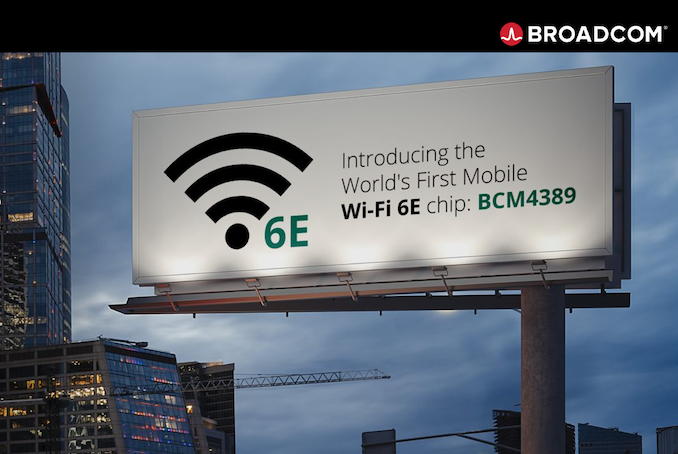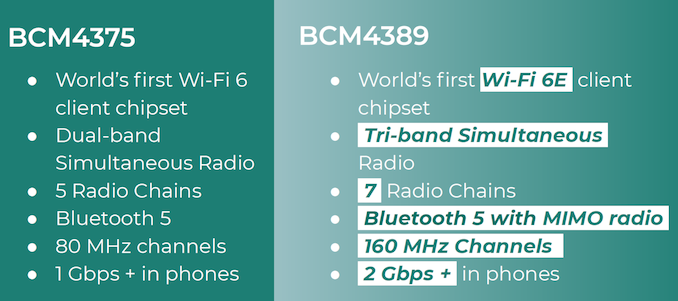Broadcom Announces BCM4389 Wi-Fi 6E Client Chipset
by Ganesh T S on February 13, 2020 5:00 AM EST- Posted in
- Networking
- Broadcom
- Bluetooth
- Wi-Fi 6E
- 6 GHz

The Wi-Fi Alliance announced the new Wi-Fi 6E terminology for 802.11ax operation in the 6 GHz band last month. At CES 2020, Broadcom announced a number of Wi-Fi 6E access point solutions. Today, Broadcom is announcing the BCM4389 client Wi-Fi 6E chipset. Consumers can expect to see the chipset in the next generation of high-end smartphones. We have already covered the advantages of Wi-Fi 6E in terms of lower latency, higher throughput, and the availability of more number of 160 MHz channels in our coverage of the Wi-Fi Alliance announcement at CES.
The BCM4389 builds upon Broadcom's success with the BCM4375, which happens to be the currently leading client Wi-Fi 6 chipset in the smartphone market. In addition to the new 6 GHz support with tri-band simultaneous operation and 160 MHz channel support, the BCM4389 also brings in additional power efficiency, thanks to its 16nm process technology and architectural improvements.
The BCM4375 is a 28nm chipset with 2x2 2.4 GHz and 2x2 5 GHz support, while the new BCM4389 adds 2x2 6 GHz to the mix. The scanning radio accounts for the additional radio chain.
The Bluetooth 5.0 functionality has also received a boost with MIMO support. Broadcom claims that the new implementation can reduce pairing time by a factor of 2 and also alleviate glitching issues when connected to Wi-Fi at the same time (compared to the BCM4375). The icing on the cake is that the MIMO support works with implicit beamforming ensuring that legacy Bluetooth devices stand to benefit too.
Silicon vendors like Broadcom and Qualcomm have been finding it relative straightforward to add 6 GHz support to their existing 802.11ax product lines. Qualcomm has not yet publicly announced Wi-Fi 6E products, though they did talk a lot about being ready for it at their Wi-Fi 6 Day last year. Broadcom, though, seems to have taken the lead with public announcements. Thanks to silicon availability, device vendors should be able to easily push out Wi-Fi 6E support in their products once the FCC clearance is in place. For consumers, the power efficiency improvements along with tri-band simultaneous operation should be very welcome news.

















18 Comments
View All Comments
yeeeeman - Thursday, February 13, 2020 - link
On 6ghz, probably yes.peevee - Thursday, February 13, 2020 - link
WiFi 6 allows splitting 160MHz into 80+80, so if there are 2 80MHz-wide channels available, it should work.MTEK - Thursday, February 13, 2020 - link
Is this *the* Wi-Fi 6E chipset to have, or are we better off waiting for them to figure out how it works in the real world?ksec - Thursday, February 13, 2020 - link
I think it would be fair to say we need some testing and real world data first. But from Spec sheet it fixed all the problem that we had with the initial launch of WiFi 6.yeeeeman - Thursday, February 13, 2020 - link
Yes, remains to be seen. Galaxy s10 has the first wifi 6 chip from broadcom and even if they say it will rock with the speeds, it cannot even keep up with last year wifi 5 solution.Makaveli - Thursday, February 13, 2020 - link
You have any links or proof to back this statement?" it cannot even keep up with last year wifi 5 solution"
Great_Scott - Thursday, February 13, 2020 - link
Well, from what I can see the upgrade is mostly useless, like 8K screens.The good news is that 2Gbps+ wireless performance will be there for once Internet connections get that fast. Perhaps 10 more years in the US.
FXi - Sunday, February 16, 2020 - link
I'd imagine that Intel and Qualcomm can't be far behind on this one. The added channels available make Wifi 6 far more viable in a "normal" busy environment than just using 5Ghz.